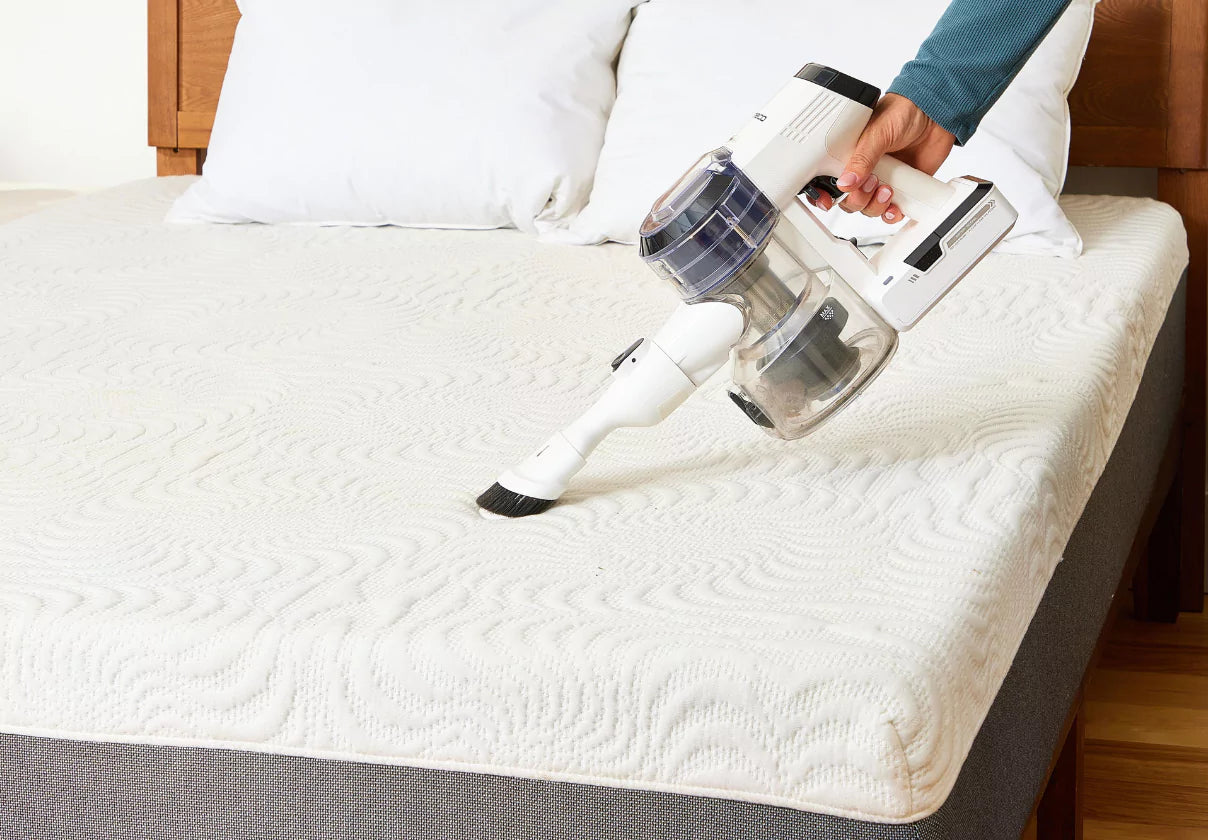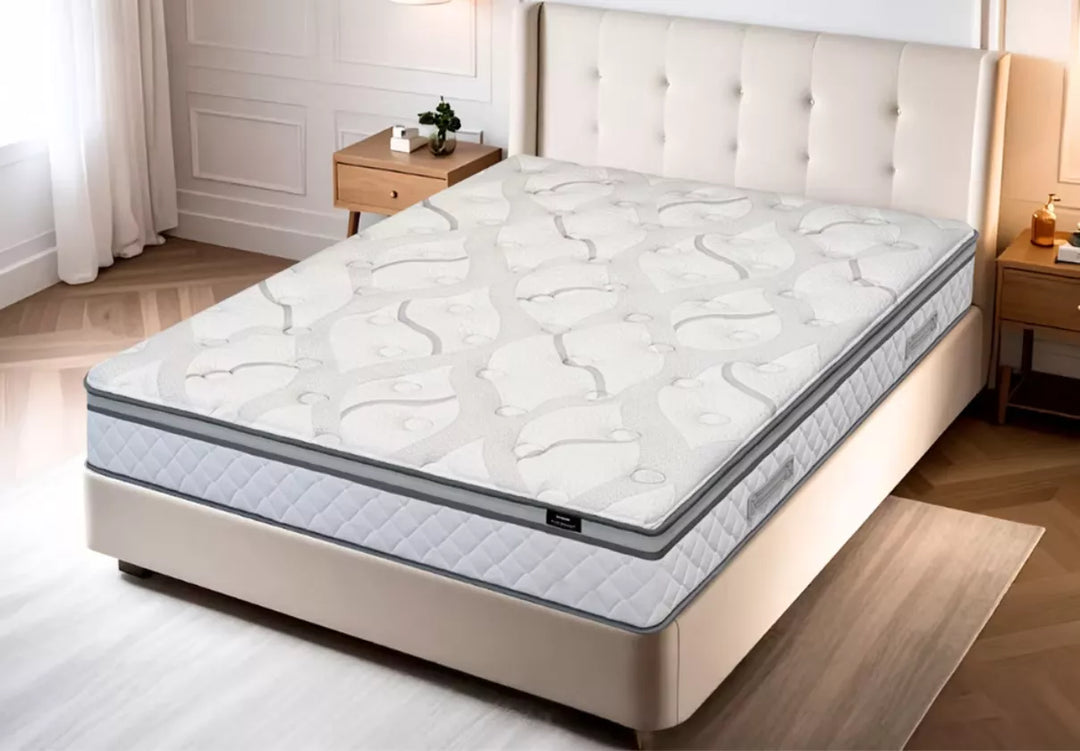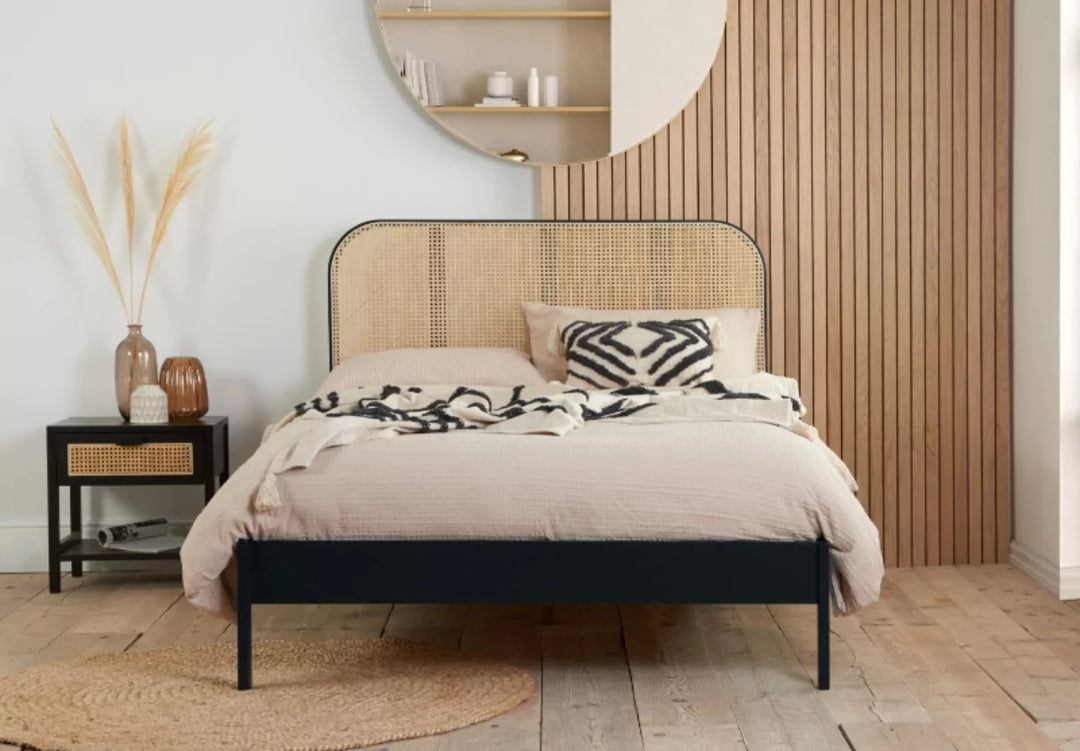
Mattress Care Guide
Everything you need to know about extending the life of your mattress
Keeping your mattress clean is essential for maintaining a healthy sleep environment and extending its lifespan. Over time, dust, sweat, allergens, and bacteria can build up, affecting both hygiene and comfort. Regular cleaning helps eliminate these contaminants, ensuring a fresher and more breathable sleeping surface.
A well-maintained mattress not only promotes better sleep but also prevents odors and stains from setting in. With the right techniques, you can deep clean your mattress efficiently, removing dirt and allergens without damaging its structure. Let’s explore the best methods for keeping your mattress spotless.
How often should I clean my mattress?
You should clean your mattress at least every six months to remove dust, allergens, and bacteria that accumulate over time. However, if you suffer from allergies or have pets, a monthly vacuuming can help maintain a healthier sleep environment. Regular spot cleaning of stains and airing out your mattress also help keep it fresh.
In addition to routine cleaning, using a mattress protector can reduce the buildup of dirt and moisture, making deep cleaning less frequent. A well-maintained mattress lasts longer and promotes better sleep hygiene.
How important is it to clean my mattress?
Cleaning your mattress is extremely important for maintaining a healthy and hygienic sleep environment. Over time, dust mites, sweat, dead skin cells, and bacteria build up, which can lead to allergies, odors, and even skin irritation. Regular cleaning helps eliminate these contaminants, ensuring a fresher and more breathable sleeping surface.A clean mattress also extends its lifespan, preventing premature wear and tear caused by moisture and dirt. With proper care, including vacuuming, stain removal, and using a mattress protector, you can enjoy better sleep quality and improved overall health.
Why do dust mites like my mattress?
Dust mites thrive in mattresses because they provide the perfect environment—warmth, moisture, and a steady supply of dead skin cells. As we sleep, our bodies naturally shed skin and release sweat, creating an ideal breeding ground for these microscopic pests. The dense fibers of mattresses trap dust, making it easy for mites to burrow and multiply.While dust mites are harmless to most people, their droppings can trigger allergies and asthma symptoms. Regular mattress cleaning, vacuuming, and using hypoallergenic protectors can help keep them under control.
What is the best way to clean a mattress?
The best way to clean a mattress involves vacuuming, spot cleaning, deodorising, and airing it out. Start by vacuuming the entire surface to remove dust, dirt, and allergens. For stains, use a mild detergent or a baking soda and water solution, gently blotting (not scrubbing) with a cloth. Sprinkle baking soda over the mattress to absorb odors, then vacuum again after a few hours. Finally, let your mattress air out by placing it near an open window or using a fan to speed up drying.How to clean your mattress at home?
The best way to clean a mattress involves vacuuming, spot cleaning, deodorizing, and airing it out. Start by vacuuming the entire surface to remove dust, dirt, and allergens. For stains, use a mild detergent or a baking soda and water solution, gently blotting (not scrubbing) with a cloth. Sprinkle baking soda over the mattress to absorb odors, then vacuum again after a few hours. Finally, let your mattress air out by placing it near an open window or using a fan to speed up drying.Keeping your mattress clean is essential for a healthier sleep environment. Follow these simple steps to freshen it up and extend its lifespan.
Let Your Mattress Breathe
When you first receive your mattress, remove all packaging immediately and allow it to air out. This helps eliminate any odors from transportation and prevents moisture buildup. If you have a memory foam mattress, let it fully expand before use.
Wash Your Bedding Regularly
To maintain cleanliness, wash your sheets and pillowcases weekly, and give them a hot wash monthly to kill dust mites and bacteria. This prevents allergens from accumulating in your mattress and keeps your bed feeling fresh.
Air Out Your Mattress Frequently
Expose your mattress to fresh air and natural light to reduce odors and deter dust mites. Each morning, fold back your duvet to let moisture escape, and when changing your sheets, leave the mattress uncovered for at least 30 minutes.
Vacuum Your Mattress Carefully
Gently vacuuming your mattress removes dust and debris, but be cautious—using too much force can damage the fabric. A handheld vacuum or a soft-brush attachment works best. While vacuuming won’t eliminate dust mites, it does reduce the buildup of dead skin cells they feed on.
By following these steps, you can keep your mattress fresh, hygienic, and in top condition for years to come.
How to get stains out of a mattress
Getting stains out of a mattress depends on the type of stain, but here are some general methods for common stains:GEENERAL CLEANING METHODS
- Vacuum the Mattress - remove dust and debris before treating stains.
- Blot (Don’t Rub) – Use a clean cloth or paper towel to absorb excess liquid.
- Apply Cleaning Solution – Use a mix of mild dish soap and warm water or a mattress cleaner.
- Blot Again – Dab with a clean, damp cloth to lift the stain.
- Dry Completely – Air dry or use a fan to prevent mold.
REMOVING SPECIFIC STAINS
Sweat & Yellow Stains Mix hydrogen peroxide (3%), baking soda, and a few drops of dish soap.
Spray the solution, let it sit for 10 minutes, then blot and let dry.
Blood Stains Use cold water (hot water sets stains). Dab with hydrogen peroxide or a salt and water paste, then blot dry.
Urine Stains (Pet or Human) Blot as much as possible. Use a solution of white vinegar and water (1:1 ratio) and blot again. Sprinkle baking soda, leave overnight, then vacuum.
Coffee or Tea Stains Mix liquid dish soap and warm water. Dab the stain and let it air dry.
How to freshen up a mattress
If you're aiming to eliminate odors from your mattress and don't have any specific stains to address, there are a few simple steps you can follow. Start by sprinkling baking soda evenly over the mattress surface, allowing it to sit for a while. Baking soda works as a natural deodoriser, absorbing unpleasant smells. After some time has passed, vacuum the mattress to remove the baking soda residue and leave behind a fresher scent.For an ongoing fresh scent, you can lightly spray the mattress with a linen spray. Be cautious not to saturate the mattress, as excessive moisture can lead to mold or mildew growth. Linen sprays are available in various pleasant scents and can help maintain a consistent freshness.
In addition to these steps, it's beneficial to let your mattress air out regularly. Take advantage of the opportunity when washing your bedding by opening windows in the bedroom to allow fresh air to circulate. This helps prevent any stale odours from lingering and promotes a healthier sleeping environment.
How to keep your mattress clean for longer
We recommend investing in a mattress topper or mattress protector for a mattress.A mattress topper not only provides an extra layer of padding but also offers the option of memory foam, regardless of your mattress type. This allows you to experience the luxurious comfort of memory foam, enhancing your sleep experience. Additionally, a mattress topper acts as a protective barrier between your top sheet and the mattress itself, reducing the risk of spills, dirt, or accidents reaching and potentially damaging your mattress.
On the other hand, a mattress protector is specifically designed to keep your mattress clean and protected. It focuses on maintaining the hygiene and longevity of your mattress without providing extra padding. These protectors are typically waterproof, dust and mite resistant, as well as hypoallergenic. By using a mattress protector, you can rest assured that your mattress is shielded from accidental spills, bacteria, and moisture, helping to preserve its quality for years to come.
When should I buy a new mattress?
Knowing when it's time to replace your mattress is crucial for maintaining optimal comfort and sleep quality. While the lifespan of a mattress can vary depending on various factors such as mattress type, quality, and usage, there are some signs that indicate it may be time for a new one. One clear indicator is when you start experiencing discomfort or pain during sleep, such as waking up with aches and stiffness. If your mattress sags, has visible signs of wear and tear, or shows uneven surfaces, it's a strong indication that it has lost its support and is no longer providing the necessary comfort for a good night's sleep. Additionally, if you find yourself consistently waking up tired or if you notice an increase in allergies or asthma symptoms, it could be a sign that your mattress is no longer providing a healthy sleep environment.Ultimately, it's recommended to evaluate your mattress's condition, consider its age (typically 7-10 years is the average lifespan), and listen to your body's needs to determine if it's time to invest in a new mattress for improved sleep and overall well-being.
It's important to note that specific care instructions may vary depending on the type of mattress you have. Always refer to the manufacturer's guidelines for cleaning recommendations and any specific precautions to take.
Explore our blog to discover effective techniques for maintaining a clean mattress. We provide a wealth of information on how to keep your mattress in pristine condition. Learn valuable tips and strategies that will help you achieve a cleaner and healthier sleeping environment.





